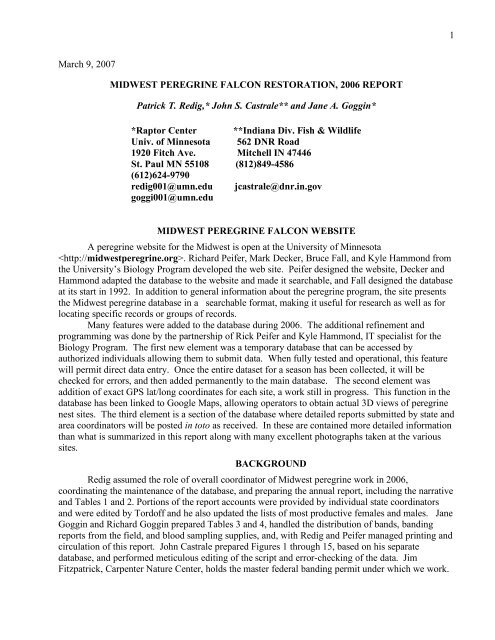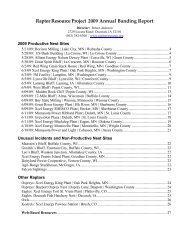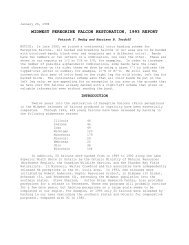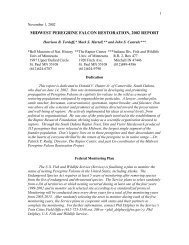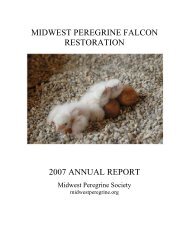2006 - Midwest Peregrine Falcon Restoration Project
2006 - Midwest Peregrine Falcon Restoration Project
2006 - Midwest Peregrine Falcon Restoration Project
You also want an ePaper? Increase the reach of your titles
YUMPU automatically turns print PDFs into web optimized ePapers that Google loves.
1<br />
March 9, 2007<br />
MIDWEST PEREGRINE FALCON RESTORATION, <strong>2006</strong> REPORT<br />
Patrick T. Redig,* John S. Castrale** and Jane A. Goggin*<br />
*Raptor Center **Indiana Div. Fish & Wildlife<br />
Univ. of Minnesota 562 DNR Road<br />
1920 Fitch Ave. Mitchell IN 47446<br />
St. Paul MN 55108 (812)849-4586<br />
(612)624-9790<br />
redig001@umn.edu jcastrale@dnr.in.gov<br />
goggi001@umn.edu<br />
MIDWEST PEREGRINE FALCON WEBSITE<br />
A peregrine website for the <strong>Midwest</strong> is open at the University of Minnesota<br />
. Richard Peifer, Mark Decker, Bruce Fall, and Kyle Hammond from<br />
the University’s Biology Program developed the web site. Peifer designed the website, Decker and<br />
Hammond adapted the database to the website and made it searchable, and Fall designed the database<br />
at its start in 1992. In addition to general information about the peregrine program, the site presents<br />
the <strong>Midwest</strong> peregrine database in a searchable format, making it useful for research as well as for<br />
locating specific records or groups of records.<br />
Many features were added to the database during <strong>2006</strong>. The additional refinement and<br />
programming was done by the partnership of Rick Peifer and Kyle Hammond, IT specialist for the<br />
Biology Program. The first new element was a temporary database that can be accessed by<br />
authorized individuals allowing them to submit data. When fully tested and operational, this feature<br />
will permit direct data entry. Once the entire dataset for a season has been collected, it will be<br />
checked for errors, and then added permanently to the main database. The second element was<br />
addition of exact GPS lat/long coordinates for each site, a work still in progress. This function in the<br />
database has been linked to Google Maps, allowing operators to obtain actual 3D views of peregrine<br />
nest sites. The third element is a section of the database where detailed reports submitted by state and<br />
area coordinators will be posted in toto as received. In these are contained more detailed information<br />
than what is summarized in this report along with many excellent photographs taken at the various<br />
sites.<br />
BACKGROUND<br />
Redig assumed the role of overall coordinator of <strong>Midwest</strong> peregrine work in <strong>2006</strong>,<br />
coordinating the maintenance of the database, and preparing the annual report, including the narrative<br />
and Tables 1 and 2. Portions of the report accounts were provided by individual state coordinators<br />
and were edited by Tordoff and he also updated the lists of most productive females and males. Jane<br />
Goggin and Richard Goggin prepared Tables 3 and 4, handled the distribution of bands, banding<br />
reports from the field, and blood sampling supplies, and, with Redig and Peifer managed printing and<br />
circulation of this report. John Castrale prepared Figures 1 through 15, based on his separate<br />
database, and performed meticulous editing of the script and error-checking of the data. Jim<br />
Fitzpatrick, Carpenter Nature Center, holds the master federal banding permit under which we work.


